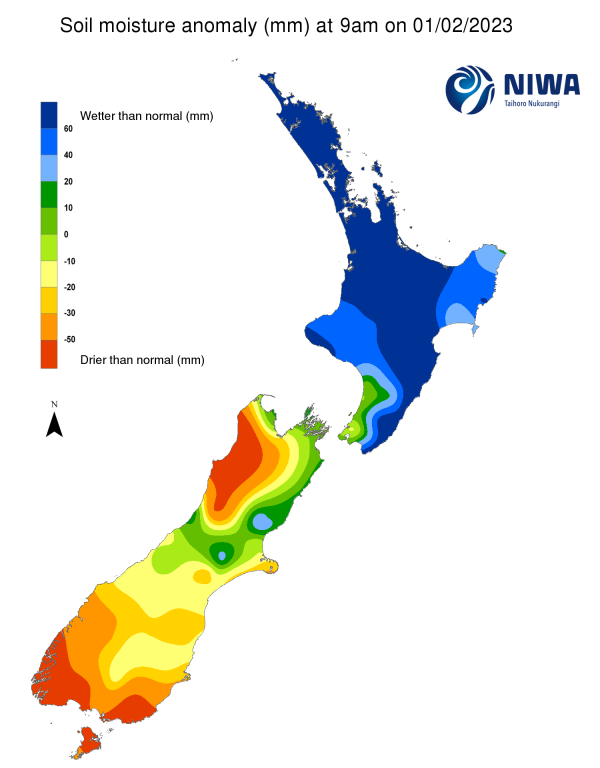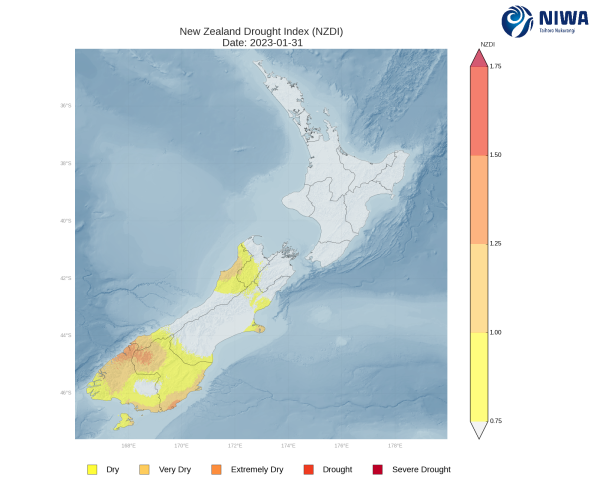A weekly update describing soil moisture patterns across the country to show where dry to extremely dry conditions are occurring or imminent. Regions experiencing significant soil moisture deficits are deemed “hotspots”. Persistent hotspot regions have the potential to develop into drought.
Facts: soil moisture
In the North Island, the past week saw multiple extreme rainfall events bring record-setting rainfall and severe flooding to parts of Northland, Auckland, and the Coromandel Peninsula. A majority of the rest of the island also saw heavy rainfall totals of 60-120 mm. However, lighter amounts of 25 mm or less were observed in coastal Gisborne and near Wellington City. This resulted in massive soil moisture increases across nearly all of the North Island, with more modest changes observed in Gisborne along with areas from Horowhenua to Wellington City. The driest soils across the North Island, when compared to normal for this time of the year, are found near Porirua, while the wettest soils for this time of the year are found from Northland to Hawke’s Bay, and south to Wairarapa.
The previous hotspot in far southern Manawatū-Whanganui dissipated in the past week, and no hotspots are currently located in the North Island.
In the South Island, rainfall amounts of 40-75 mm in much of the West Coast, along with parts of Tasman, northern Canterbury, and isolated portions of Otago and Southland. Elsewhere, rainfall amounts were typically 25 mm or less. This resulted in moderate soil moisture increases for Westland and northern Canterbury, although little change to soil moisture levels was observed elsewhere. The driest soils in the South Island, when compared to normal for this time of the year, are located in Buller, Fiordland, coastal Southland, and Stewart Island, while the wettest soils for this time of the year are found in parts of northern Canterbury.
South Island hotspots are currently located near Nelson, in Banks Peninsula, southern Canterbury, nearly all of Otago, and coastal Southland. In addition, a new hotspot has formed in the past week in far northern Buller District. As of 31 January, the New Zealand Drought Index (NZDI) map below shows that dry or very dry conditions are currently located in areas north of Christchurch, Banks Peninsula, Buller and southern Tasman, along with most of the lower West Coast, Otago, Southland, and Stewart Island. In addition, southeastern and far interior Otago, along with northern Fiordland are experiencing extremely dry conditions.
Outlook and soil moisture
In the North Island, more moderate to heavy rain could impact parts of Auckland, northern Waikato, and Bay of Plenty today and early Friday (2-3 February). Most locations will experience a mostly dry weekend before an arriving front brings moderate rainfall to a majority of the North Island on Sunday night and Monday morning (5-6 February). Other than a few scattered afternoon showers, most of next week should be fairly dry. Weekly rainfall totals of 25-60 mm could be commonplace across most of the North Island, although lesser amounts are likely in Northland.
Due to the expected rainfall in the next week, little change in soil moisture levels is likely across most of the North Island. However, Northland could see slight decreases. No hotspots are expected to form in the next week.
In the South Island, periods of heavy to very heavy rainfall are likely in the West Coast between today and Sunday (2-5 February). By Sunday, localised flooding could occur. Otago and Southland may see a few showers and thunderstorms today and Friday, although there will be a better chance for moderate to briefly heavy rain to impact the upper and eastern South Island on Sunday (5 February). Between Tuesday and Thursday (7-9 February), the passage of a couple of weak fronts may deliver some light rainfall. Weekly rainfall totals could reach or exceed 300 mm in the central and lower West Coast, with up to 120 mm farther north. Amounts of 40-75 mm will be possible in both the upper and lower South Island, with lighter amounts of 30 mm or less along the east coast.
Due to the expected rainfall in the next week, soil moisture levels could increase markedly in both the upper and lower South Island and especially in the West Coast. However, little change may be observed along the east coast. The current hotspot near Nelson will likely dissipate in the next week, while those in the lower South Island may weaken somewhat. However, the hotspots located in Canterbury may not see significant changes.
Despite the expected short-term rainfall, persistently low rainfall and above average temperatures could result in an escalation of the dryness across the lower South Island during February. This may result in the development of meteorological drought in parts of Otago and Southland later in the month.
For more information on the potential for dryness in the weeks to come, please check out the drought forecasting tool, a collaboration between NIWA and the Ministry for Primary Industries.
Background
Hotspot Watch: a weekly advisory service for New Zealand media. It provides soil moisture and precipitation measurements around the country to help assess whether extremely dry conditions are imminent.
Soil moisture deficit: the amount of water needed to bring the soil moisture content back to field capacity, which is the maximum amount of water the soil can hold.
Soil moisture anomaly: the difference between the historical normal soil moisture deficit (or surplus) for a given time of year and actual soil moisture deficits.
Definitions: “Extremely” and “severely” dry soils are based on a combination of the current soil moisture status and the difference from normal soil moisture (see soil moisture maps)
Hotspot: A hotspot is declared if soils are "severely drier than normal" which occurs when Soil Moisture Deficit (SMD) is less than -110 mm AND the Soil Moisture Anomaly is less than -20 mm.

Pictured above: Soil Moisture Anomaly Maps, relative to this time of year. The maps show soil moisture anomalies over the past two weeks.
As of 31 January, the New Zealand Drought Index (NZDI) map below shows that dry or very dry conditions are currently located in areas north of Christchurch, Banks Peninsula, Buller and southern Tasman, along with most of the lower West Coast, Otago, Southland, and Stewart Island. In addition, southeastern and far interior Otago, along with northern Fiordland are experiencing extremely dry conditions. Please note: some hotspots in the text above may not correspond with the NZDI map. This difference exists because the NZDI uses additional dryness indices, including one which integrates the rainfall deficit over the past 60 days. Changes are therefore slower to appear in the NZDI compared to soil moisture anomaly maps that are instantaneously updated.



